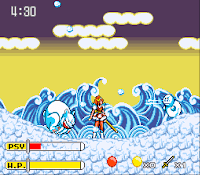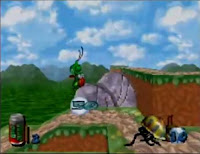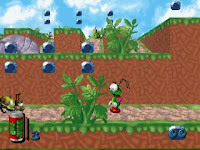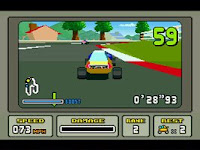 Part of the fun of writing these reviews is walking into a retro games store and leaving with a few games solely based on how ridiculous their names are. And while Kendo Rage may not be the strangest name I've seen, it does possess its own unique ridiculousness. A quality that shines throughout Seta U.S.A.'s 1993 adventure. But does Kendo Rage possess the violent beauty of the martial arts, or is it merely an enraging experience?
Part of the fun of writing these reviews is walking into a retro games store and leaving with a few games solely based on how ridiculous their names are. And while Kendo Rage may not be the strangest name I've seen, it does possess its own unique ridiculousness. A quality that shines throughout Seta U.S.A.'s 1993 adventure. But does Kendo Rage possess the violent beauty of the martial arts, or is it merely an enraging experience?You play as Jo, a girl in love with kendo and the martial arts, who was sent by her parents to Japan for the summer. There she has enrolled in Honest Osaki's Kendo School and Used Car Sales, to be trained by one of the greatest Kendo masters in Japan. Once Jo arrives, Osaki finds her a quiet mountain cabin six hours from school. While rushing to school on the first day, Osaki surprises her and informs her that she can call him Bob, and also that she must crush the rotten evildoers that are along her path to school. He then gives her a talisman from the great wizard Hiundai, which protected the great warrior Farratti as he did battle with the evil General Moto's legions in the battle of Detroit. The charm grants Jo the magical powers she needs to defeat evil and reach school in time (more or less).
I mentioned already that the game is ridiculous, but I failed to mention that the game revels in its goofiness. From the pun heavy story to the beyond groan-worthy level opening and ending quips, the game takes great delight in making the player laugh at just how bad some of the jokes are. This lack of seriousness is a definite plus for the game as it gives Jo, Osaki, and even the bosses a quick shot of character and personality.
Everything about how the game was crafted visually bleeds charm as if the designers had been cut with a knife made of orange tuxedos. Every level is drastically different than the last. Ranging from the predawn mountains to under the sea. Each one maintains a striking distinction from the last that, and more often than not, makes the player wonder if Jo's gotten lost.
That ridiculousness also makes its way into the gameplay as well, but unfortunately, it's a bit less endearing there. Like in the Prince of Persia, the game's clock is constantly ticking, demanding that Jo complete all seven levels before it is time for school. This keeps the pace of the game fast. However, the controls are just not tight enough for that.
This is due in part to the fact that Jo accelerates slowly. Like Sonic, it takes Jo a moment to get to her normal movement speed, a speed that she can, also like Sonic, surpass when running down a hill. The problem with this is that, unlike Sonic, Jo's not restricted by inertia, but a slight stutter step that she takes every time she starts moving. This creates a slight feeling of lag between when the player moves and the character complies. The slight frustration of this is exacerbated by enemies that simply appear in front of Jo.
Luckily, Jo is no slouch when it comes to combat. Much like in a shooter, her standard attack can be augmented by three elemental powers. The fire element grants a sword with longer reach, while the water element creates a crescent of energy. The wind element, probably the most useful in terms of pure combat abilities, summons a flurry of thrusts.
Each strike can be additionally enhanced by allowing the PSY meter to build, which does so as long as Jo does not attack or get hit. Once the bar is filled at least halfway, the next strike will have an added effect: A beam of flame, a spread shot of ice, or a greater flurry of thrusts. These magical strikes can help swing a battle back in Jo's favor.
Unfortunately, the manner in which Jo selects which element she wants to use is unwieldy at best. Jo must attack a specific enemy that appears at certain points in the level. As the creature flits around the screen, the orb in its possession alternates between four colors. Attacking the enemy while it's holding the red, green, or blue orb will net Jo the effect of that element, but will not power up her attack if she picks the same element as it would in a shooter. The fourth color, yellow, allows Jo to take one extra hit by creating a shield in front of her when an attack comes near.
 The elemental system is a nice idea as it grants a slightly deeper element of strategy to the bosses. The first boss is easier when fought with fire, while the second boss is simpler when fought with wind, and so on. The problem is that the orb-carrying enemies appear so suddenly, that the player is likely to attack one as soon as it shows up, which more often than not, results in having the wrong element for a boss fight. This can become extremely frustrating, especially as once that mistake is made, the player has no choice but to use an ineffective element and probably waste a life.
The elemental system is a nice idea as it grants a slightly deeper element of strategy to the bosses. The first boss is easier when fought with fire, while the second boss is simpler when fought with wind, and so on. The problem is that the orb-carrying enemies appear so suddenly, that the player is likely to attack one as soon as it shows up, which more often than not, results in having the wrong element for a boss fight. This can become extremely frustrating, especially as once that mistake is made, the player has no choice but to use an ineffective element and probably waste a life.This is the game's greatest flaw, especially near the end when enemies are darting in on all sides. The player grows so used to attacking everything before Jo's sluggish controls become a problem, that the elemental power up carrier seems just like any other enemy. And as the red element becomes too sluggish and narrow focused to really hold up to the onslaught, there becomes a greater possibility of death if the wrong element is selected.
Beyond that, Jo possesses a dash move that causes her to surge forward surrounded by energy, destroying any enemy that gets in her way. However, as this move takes almost a fourth of her health and only has slightly more range and power than her fully charged attacks, it ends up being more costly than effective.
Oddly enough, the game's soundtrack might be the best thing about the game. It's a bumpy and energetic collection of songs, reminiscent of the early Sonic games. It's a good indicator of the effort that Seta U.S.A put into creating the game.

In the end, though, Kendo Rage is just a mediocre action-platformer. It has charm to spare and wonderful music, but that doesn't make up for the frustration caused by how the elemental powers are delivered. If you're looking for a quirky, Japanese game with a goofy localization, Kendo Rage might provide some silly fun. Anyone else should just let this rage pass them by.












